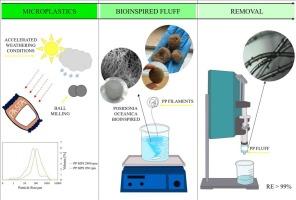Green production of bioinspired reusable PP fluff for true-to-life microplastics removal from water
IF 9.2
2区 工程技术
Q1 ENERGY & FUELS
引用次数: 0
Abstract
Microplastic pollution is one of the most discussed environmental concerns. However, predicting the real behaviour of microplastics and producing environmentally friendly systems for their removal is still challenging. To address this, we propose an innovative and solvent-free method for producing reusable 3D fibrous fluff, specifically designed to remove microplastics from water. Fluff morphology is bioinspired by the natural structure of Posidonia Oceanica Egagropiles, since they are able to trap microplastics from water. Polypropylene (PP) PP fluff has been produced by combining a melt spinning process and a vortex motion field generated in distilled water. True-to-life microplastics were obtained by subjecting PP pasta bags to accelerated weathering and mechanical fragmentation. This protocol enables the generation of microplastics with properties that closely resemble real-world microplastics, in terms of chemical and physical characteristics. To better understand their settling behaviour in water and, therefore, to facilitate their removal, fluidodynamic modeling have been adopted, considering the real properties of the particles before and after photo-oxidation. The proposed PP fluff was finally used to filter the true-to-life microplastics, undergoing up to 10 cycles of use with almost unaltered performance. It ensured high removal efficiency, especially for larger particles, while a detailed analysis of smaller particles fraction was performed, by comparing ponderal and numerical removal efficiency.

绿色生产生物灵感可重复使用的PP绒毛,从水中去除真正的微塑料
微塑料污染是人们讨论最多的环境问题之一。然而,预测微塑料的真实行为并生产环境友好型系统来去除它们仍然具有挑战性。为了解决这个问题,我们提出了一种创新的无溶剂方法来生产可重复使用的3D纤维绒毛,专门用于去除水中的微塑料。绒毛形态的生物灵感来源于Posidonia Oceanica Egagropiles的自然结构,因为它们能够从水中捕获微塑料。采用熔体纺丝法和蒸馏水涡流场相结合的方法制备聚丙烯(PP) PP绒毛。通过对PP面食袋进行加速风化和机械破碎,获得了逼真的微塑料。该协议使微塑料的产生在化学和物理特性方面与现实世界的微塑料非常相似。为了更好地了解它们在水中的沉降行为,从而促进它们的去除,我们采用了流体动力学模型,考虑了光氧化前后颗粒的真实特性。提议的PP绒毛最终被用来过滤真正的微塑料,经过10次循环使用,性能几乎没有变化。它确保了高的去除效率,特别是对于较大的颗粒,同时通过比较固体和数值去除效率,对较小颗粒的分数进行了详细的分析。
本文章由计算机程序翻译,如有差异,请以英文原文为准。
求助全文
约1分钟内获得全文
求助全文
来源期刊

Sustainable Materials and Technologies
Energy-Renewable Energy, Sustainability and the Environment
CiteScore
13.40
自引率
4.20%
发文量
158
审稿时长
45 days
期刊介绍:
Sustainable Materials and Technologies (SM&T), an international, cross-disciplinary, fully open access journal published by Elsevier, focuses on original full-length research articles and reviews. It covers applied or fundamental science of nano-, micro-, meso-, and macro-scale aspects of materials and technologies for sustainable development. SM&T gives special attention to contributions that bridge the knowledge gap between materials and system designs.
 求助内容:
求助内容: 应助结果提醒方式:
应助结果提醒方式:


